
About UsThe Numismatic Bibliomania Society is a non-profit organization promoting numismatic literature. For more information please see our web site at coinbooks.org SubscriptionsThose wishing to become new E-Sylum subscribers (or wishing to Unsubscribe) can go to the following web page link MembershipThere is a membership application available on the web site Membership Application To join, print the application and return it with your check to the address printed on the application. Membership is only $15 to addresses in the U.S., $20 for First Class mail, and $25 elsewhere. For those without web access, write to: David M. Sundman, Secretary/TreasurerNumismatic Bibliomania
Society AsylumFor Asylum mailing address changes and other membership questions, contact David at this email address: dsundman@LittletonCoin.com SubmissionsTo submit items for publication in The E-Sylum, just Reply to this message, or write to the Editor at this address: whomren@coinlibrary.com
BUY THE BOOK BEFORE THE COINYou won't regret it! |
- WAYNE'S WORDS: THE E-SYLUM NOVEMBER 8, 2009
- MOULTON WINTER 2009/2010 FIXED PRICE LIST AVAILABLE
- 1850 ECKFELDT-DUBOIS NEW VARIETIES WITH GOLD SAMPLES SOLD
- NEW BOOK: WORLD PAPER MONEY, SPECIALIZED ISSUES, 11TH EDITION
- CD BOOK REVIEW: HAXBY'S U.S. OBSOLETE BANK NOTES
- BOOK REVIEW: RED BOOK OF U.S. COINS - PROFESSIONAL EDITION
- DECEMBER 2009 COLONIAL NEWSLETTER PUBLISHED
- MORE ON THE REPRINT OF THE FIRST SIX VOLUMES OF THE NUMISMATIST
- MORE ON CARTOUCHE
- UPDATE: COIN MOTTO/INSCRIPTION TRANSLATION WEB SITE
- WANTED: NUMISMAPEDIA - AN ENCYCLOPEDIA OF NUMISMATICS
- OBAMA'S MEDAL MIXUP MISHAP
- DEALER INGRID O'NEIL ON OLYMPIC MEDALS
- AMATEURS, PSEUDOSCHOLARSHIP AND NUMISMATIC WORKS
- QUERY: ITALIAN MAKER OF COIN AND MEDAL REPLICAS SOUGHT
- QUERY: COUNTERFEIT LIBERTY HEAD NICKEL MOLD
- STANFORD WHITE AND AUGUSTUS SAINT-GAUDENS
- ARTICLE HIGHLIGHTS CHALLENGE COIN SELLER'S BUSINESS
- PERSONAL TOKENS OF COLLECTOR JERRY ADAMS
- MORE ON JAMES J. CURTO
- AUTHOR GINGER RAPSUS ON WRITING CLAD COINAGE BOOK
- NATIONAL PUBLIC RADIO SEGMENT ON LOS ANGELES ANA CONVENTION
- BROOKLYN WOMAN FINDS ARTIST'S CENT MADE OF GOLD
- ARTICLE HIGHLIGHTS ASHMOLEAN COIN COLLECTION
- BULGARIAN MUSEUM SEEKS FUNDS TO DISPLAY ANCIENT COIN HOARD
- FEATURED WEB PAGE: WWI EMERGENCY MONEY
WAYNE'S WORDS: THE E-SYLUM NOVEMBER 8, 2009

Among our recent subscribers are J. A. McNerney, Eric Crawford, and Jeff Wilson. Welcome aboard! We now have 1,269 subscribers.
Many thanks to John Salyer, who assisted with the images this week. We have another whopper of an issue, and John's help came in handy.
This week we open with Karl Moulton's new fixed price list and word of the sale of one of the great rarities in U.S. numismatic literature. In reviews and new books this week we cover world paper money, obsolete U.S. paper money, and the new Professional Edition "Redbook".
Other topics this week include coin mottos, Olympic medals, Stanford White and Augustus Saint-Gaudens, Challenge Coins, James Curto, and a U.S. cent made of gold. To learn about gold medals that aren't gold and numismatist Hillbilly Jim the wrestler, read on.
Wayne Homren
Numismatic Bibliomania Society
MOULTON WINTER 2009/2010 FIXED PRICE LIST AVAILABLE
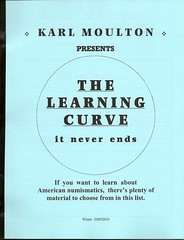 Numisamtic literature dealer Karl Moulton has issued his Winter 2009/2010 fixed price list. The 46-page list focuses on auction catalogs but also includes a number of books. For more information, see:
www.coincats.com
Numisamtic literature dealer Karl Moulton has issued his Winter 2009/2010 fixed price list. The 46-page list focuses on auction catalogs but also includes a number of books. For more information, see:
www.coincats.com
1850 ECKFELDT-DUBOIS NEW VARIETIES WITH GOLD SAMPLES SOLD
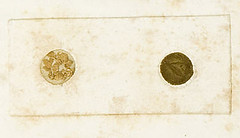 Pacific Auction Galleries offered a ratty copy of a rare and important numismatic book in their Americana Sale #415 on November 5th.
Lot 82 is the 1850 Eckfeldt-DuBois New Varieties of Gold and Silver Coins with samples of gold fresh from the California gold fields.
It sold for $3,600.
-Editor
Pacific Auction Galleries offered a ratty copy of a rare and important numismatic book in their Americana Sale #415 on November 5th.
Lot 82 is the 1850 Eckfeldt-DuBois New Varieties of Gold and Silver Coins with samples of gold fresh from the California gold fields.
It sold for $3,600.
-Editor
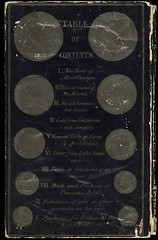
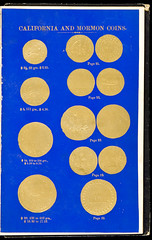
- Author: Eckfeldt, Jacob R[eese] & William E. Du Bois
- Title: New Varieties of Gold and Silver Coins, Counterfeit Coins, and Bullion, with Mint Values
- Place: Philadelphia
- Publisher: Published by the Authors
- Date: 1850
60 pp. + leaf on Mormon coins. Steel-engraved frontispiece. (untitled) of the U.S. Mint; leaf printed in gold on blue paper showing varieties of California and Mormon coins; actual samples of California gold underneath two small Formica disks mounted on p.45. 7x4¼, original dark blue paper over boards, front cover lettered in gilt with gilt-embossed depictions of 5 gold coins, both obverse and reverse for a total of 10 images, rear cover lettered in silver with silver-embossed depictions of 5 silver coins, both obverse and reverse for a total of 10 images; all edges gilt. First Edition.
Rare first edition of one of the most sought-after and most fragile books on gold coinage at the time of the California Gold Rush. The second edition of the following year, with slightly expanded text, did not contain the original samples of California gold which add to the unique character the work.
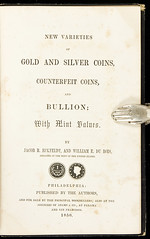
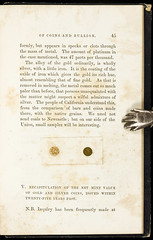
Streeter calls the slender volume "An important reference book for the beginning of gold mining in California," and Wheat remarks that "Actual samples of California `grain' and `bar' gold, and reproductions of privately minted 1849 gold coins of California and of the Mormons in Utah render this little book an extraordinary and colorful contemporary souvenir of the Gold Rush."
Pages 21 to 31 describe four varieties of California gold coins issued from the following mints: "N.G. & N." of San Francisco, Oregon Exchange Company, Miners' Bank of San Francisco, and Moffat & Company of San Francisco; chapter IV is entitled "Gold from California."
To read the complete lot description, see: New Varieties of Gold and Silver Coins, Counterfeit Coins, and Bullion, with Mint Values (www.pbagalleries.com/search/item204677.php?)
NEW BOOK: WORLD PAPER MONEY, SPECIALIZED ISSUES, 11TH EDITION
George Cuhaj writes:
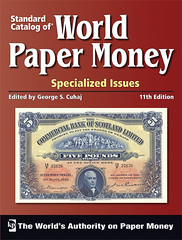 The 11th edition of the Standard Catalog of World Paper Money, Specialized issues is now available at www.shopnumismaster.com
1246 pages, lots of images, new variety listings, price changes throughout.
The 11th edition of the Standard Catalog of World Paper Money, Specialized issues is now available at www.shopnumismaster.com
1246 pages, lots of images, new variety listings, price changes throughout.
There's nothing that compares to the breadth and depth of the Standard Catalog of World Paper Money series, especially when it comes to specialized bank notes. This recently released 11th edition of the Standard Catalog of World Paper Money Specialized Issues is the largest English-language reference about this innovative and historically rich form of paper money.
In this single book you'll find:
- Listings for bank notes issued by states, municipalities, private companies, provincial, private and commercial banks from every corner of the world
- 27,500 note varieties
- Up-to-date pricing in three grades of condition
- More than 11,000 illustrations of notes
If world paper money fascinates you, then this guide is a must for your library of references.
For more information, see: www.shopnumismaster.com
CD BOOK REVIEW: HAXBY'S U.S. OBSOLETE BANK NOTES
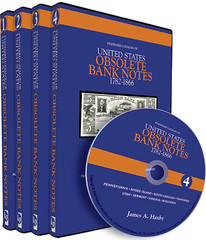 The biggest news in the syngraphics book field of late is the announcement that the publisher of this periodical is re-releasing Jim Haxby's monumental 1988 four-volume opus United States Obsolete Bank Notes, 1782-1866 in CD format. Long out of print (my wife bought my set for me as a Christmas present in 1988), sets have been retailing for $800 more-or-less when available. Prominent currency dealers had "open" buy ads for sets.
The biggest news in the syngraphics book field of late is the announcement that the publisher of this periodical is re-releasing Jim Haxby's monumental 1988 four-volume opus United States Obsolete Bank Notes, 1782-1866 in CD format. Long out of print (my wife bought my set for me as a Christmas present in 1988), sets have been retailing for $800 more-or-less when available. Prominent currency dealers had "open" buy ads for sets.
Although state obsolete bank note books exist for a number of states either privately or under the auspices of the Society of Paper Money Collectors Wismer Project, Dr. Haxby's accomplishment in cataloging the breadth of obsolete bank notes in an informed and illustrated way was unprecedented. It was another in KP founder Chet Krause's series of massive compendia in all cataloging fields, a hallmark then and since for this Wisconsin-based enterprise.
I'll leave it to KP pitchmen to provide the particulars on this set and close the sale, but from one who has used these volumes in my personal collecting and professional career for more than two decades, ANY collector worth his/her salt MUST have the printed or now electronic versions of these monumental tomes. The publisher is even offering state-by-state downloads, a definite plus.
To read the complete article, see: Recent Paper Money Works Remake Classics New Again (www.numismaster.com/ta/numis/Article.jsp?ad=article&ArticleId=8156)
BOOK REVIEW: RED BOOK OF U.S. COINS - PROFESSIONAL EDITION
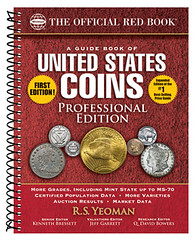 This First Edition of, "A Guide Book of United States Coins, Professional Edition" by Senior Editor, Kenneth Bressett, Valuation Editor, Jeff Garrett and Research Editor, Q. David Bowers is the 15th reference published by Whitman Publishing, LLC using "The Official Red Book" name.
This First Edition of, "A Guide Book of United States Coins, Professional Edition" by Senior Editor, Kenneth Bressett, Valuation Editor, Jeff Garrett and Research Editor, Q. David Bowers is the 15th reference published by Whitman Publishing, LLC using "The Official Red Book" name.
The Guide Book of United States Coins (The Red Book) published annually is the best selling numismatic book in the world. This "Professional Edition" of the Red Book is spiral bound, soft cover, 8.5 x 11, in full color and has 384 pages. The reference covers all U. S. federal coin series from the ½ cent piece to the gold double eagles. U. S. commemoratives (1892-1954) along with mint and proof sets are also covered.
The authors of this Professional Edition mention that this isn't a replacement for the annual Guide Book of U. S. Coins (Red book). We do feel that the areas not covered such as grading, values for lower graded coins, history of coins, coins from treasures and hoards, colonial & early American coins and tokens, bullion coins, private & territorial gold, hard times & civil war tokens, Confederate, Hawaiian, Puerto Rican & Philippine coins and Alaskan tokens, are areas that most professionals do not use the Red Book for anyway. Also most dealers always have an old standard red book lying around if they need that kind of information.
The professional edition covers, denomination introductions, type-by-type studies, mintages, certified populations, valuations, auction records (from the past five to ten years), investing in rare coins - using common sense, learn about grading and what you are buying, understanding the general market and learning from the experts. We especially liked the overviews of all the denominations that were issued. We cannot help but think that this information will help even the most advanced dealer, collector or investor to be a better seller or buyer of coins.
As an example of this on page 17 of an overview of half cents, "One curious and readily available variety off the 1828 half cent has 12 stars instead of the standard 13. However, in choice MS the 12-stars issue becomes a rarity, for, unlike the 13-stars issue, none were ever found in hoards." We found that some of these overviews contained very valuable information not found elsewhere. We also liked the recommended readings after the overviews. If you need additional information, these lists will lead you to the information you need. The photos of the over dates and other varieties are more extensive than in the standard red book and the pictures are larger and show more clearly what the variety looks like.
We attend many coin shows in all parts of the country and see very few Red Books (A Guide Book of United States Coins) behind dealer's tables. In the future we think that you will see many of this "Professional Edition," being carried and used during shows. We feel dealers and advanced collectors need it to give them additional knowledge to make more knowledgeable decisions. This is another "slam dunk" reference that will probably become the second leading seller in the Whitman Publishing chain of fine numismatic references. We highly recommend it to collectors, dealers or anyone who buys or deals in U. S. coins. For information on purchasing this Professional Edition, which sells for $29.95 you can contact: Whitman Publishing, LLC, 3103 Clairmont Road, Suite B, Atlanta, GA 30329 or phone (800) 546 - 2995 or visit their site at: info@whitmanbooks.com
I received my copy of the Professional Edition last week, but held off on my review knowing that the Wilsons planned to send their comments this week.
I think it's an interesting culmination of the various format experiments Whitman has made to their classic product. The Professional Edition is spiral bound (great for a frequently-used reference), is the jumbo size of the large-print edition (also very useful), and has all of the great color photography, clear tabular mintage and pricing information of all the editons. In many ways it combines the best of all the other formats.
The lack of prices to lower grades is a drawback, I think, but the inclusion of auction records is very valuable. One aspect of the large print edition I would have enjoyed seeing is enlarged color photos. But it's difficult if not impossible, to squeeze every possible feature into one book, so readers will have to make do with more than one book. I'll give the Professional Edition a thumbs up, although I do empathize with those who grouse about needing multiple books to properly cover the territory.
To read the earlier E-Sylum article, see: NEW BOOK: RED BOOK OF U.S. COINS - PROFESSIONAL EDITION (www.coinbooks.org/esylum_v12n38a07.html)
THE BOOK BAZARRE
DECEMBER 2009 COLONIAL NEWSLETTER PUBLISHED
The December 2009 issue of The Colonial Newsletter: A Research Journal in Early American Numismatics (CNL) has been published. This issue starts with three technical notes from David Gladfelter concerning the colonial paper money of New Jersey. His first submission, titled "New Jersey's Numismatic Sun," discusses a printer's error found on the 1763 £3 bill. Interestingly, this bill was counterfeited and, believe it or not, the counterfeiters corrected the error.
This report is followed by another technical note by David that illustrates an Andrew Bradford invoice to the Province of New Jersey. Bradford had printed the March 25, 1733, issue of New Jersey bills of credit. The invoice shows that John Peter Zenger, the printer and publisher of the New-York Weekly Journal, was involved in producing New Jersey's bills of credit. Zenger is best known for his arrest and trial for criminal libel against New York's royal governor, William Crosby. Zenger was acquitted because it was determined that he was telling the truth, which established our freedom of the press.
A final technical note by David reports the discovery of a previously unknown merchant's small change note. Dated February 23, 1775, and issued by Robert Drummond and Richard Ludlow of Acquackanonck, New Jersey, this three shilling note was payable in New York currency at their stores. The note was printed by Hugh Gaine, a prolific printer and publisher located in New York City who opened his business in 1752.
A discovery by watch collector Tom Brown sheds more light on the Mott token. Numismatists have debated for years whether the token was produced in the year of its date, 1789, or if it was issued in the nineteenth-century and backdated to that year. It was even questionable as to who issued the token. Initially it was attributed to William and John Mott of New York City until it was learned that they were grocers. Then it was discovered that Jordan and James Mott were watch and clock makers and much more likely candidates.

Tom acquired a pocket watch and in the back of the case he found several watch papers. One of the papers was issued by James S. Mott, the son of Jordan Mott. Importantly, the watch paper stated that their firm had been established in 1789, the same date on the token. Therefore, it does seem that the firm of Jordan and James Mott did issue the token and the date on the token commemorates the establishment of their business.
Last year, in conjunction with the annual C4 convention held in Boston, the Bostonian Society placed an historic marker to commemorate the John Hull mint. Established in 1652, this mint produced several denominations of silver coinage for over 30 years, including the well-known Pine Tree shilling. In association with the dedication ceremony of the historic marker, Lou Jordan, author of the book John Hull, the Mint and Economics of Massachusetts Coinage, presented a lecture at the convention describing why the mint was founded. CNL is pleased to present the full text of Lou's well researched lecture along with added citations and footnotes.
On November 11, 2006, the American Numismatic Society held a Coinage of the Americas Conference (COAC) on the subject of the St. Patrick coinage. Oliver Hoover not only presented a paper at the conference but he also edited the proceedings. Thus, Oliver is well aware of the many issues concerning this enigmatic coinage. In the final article of this issue, Oliver examines the claim that on the coinage St. Patrick is shown wearing the vestments of an Anglican bishop although he was a Catholic saint.
CNL is published three times a year by The American Numismatic Society, 75 Varick St., 11th Floor, New York, NY 10013. For inquires concerning CNL, please contact Megan Fenselau at the preceding postal address or e-mail membership@numismatics.org or telephone (212) 571-4470 ext. 117.
MORE ON THE REPRINT OF THE FIRST SIX VOLUMES OF THE NUMISMATIST
Regarding Howard Cohen's query about the reprint of the first six volumes of The Numismatist, George Kolbe writes:
I believe the likely answer is that 100 orders were never received for The Numismatist official reprint and that it never reached fruition.
It was Floyd Hazelwood, operating as Olympic Press, who reprinted the first six volumes of The Numismatist. Many reprints of Numismatist articles and Munro's Coins of Japan were among his other projects. Floyd told me that he and his son had no prior experience printing but that they bought a printing press, installed it in their basement and went to work! Over the years, Floyd would sell me batches of The Numismatist reprint which I generally sold for around $50. I think he probably had a quantity of unbound copies from the original print run and bound them up in small groups. I have seen a number of distinct crimson cloth bindings over the years.
In early 1977, I bought Floyd Hazelwood's library. Hailing from Salina, Kansas, Floyd was associated with the railroads and his library was sent to me via rail. When it arrived, the bottoms of many cartons were oil stained and the boxes were, by necessity, stacked outside my front door, where I unpacked them before bringing them into the house (it was not until the following year that I moved from home to an office).
Floyd had a fine library and most of it was sold in my third auction sale. Although Floyd and I never met we got along well and sort of kept in touch. When he passed away, I continued to buy things from his son, whose first name escapes me at present. Their substantial contribution to the dissemination of numismatic information seems hardly appreciated, then or now.
Ken Hallenbeck writes:
I found out about the reprint after the fact. I did some research and found the man who reprinted them from Kansas, wrote and ordered one. Seems like I got one of the last ones available, if not the last one. Vaguely recall the cost was $35 more or less. This "completed" my set of The Numismatist.
Gary Dunaier writes:
Let's see... it's been 46 years since the reprint was published... a copy just sold for $710... isn't it about time the ANA came out with a new printing at a reasonable price?
Incidentally, regarding the Frank Katen invoice indicating a 1965 sale for $50 - that $50 translates to $342.81 in 2009 dollars, so it didn't take very long for the book to become a pricey volume.
Paul Johnson writes:
I read with interest the information about the ANA board authorizing the reprint of the first six volumes of The Numismatist in 1963. I have the hardcopy volume which I purchased a few years ago from a local numismatist who was disposing of his library. He had purchased the volume in 1963 as a member of the ANA. His price to me a few years ago was $100 which I then thought was fair. There is a lot of interesting reading in the first six volumes and I have not had any regrets in purchasing it.
David Gladfelter writes:
There is another reprint of volume one only. The quality is not very good. I bought this from Bebee's – his 1976 price list says that it cost me $7.50. I sold it off when I got the Hazelwood reprint.
Weird, isn't it, that it took 15 years to get the first 100 orders at $8, then two years later the price jumped to $50, and now it's $700. You would think that ANA would go for a second printing to satisfy this sudden demand.
Myron Xenos writes:
It was at least 15 or 20 years ago that The Money Tree received a box of the Numismatist reprint of the first six volumes from Sandy Durst, totally unexpected, almost like a throwaway punchline on a sitcom. I do remember my partner, Ken Lowe, hyperventilating as he always did upon the arrival of anything rare and unusual.
I can't recall what method we used to sell them, but they sold in a heartbeat. I don't think we ever sold more than one or two others after that in our 20 years in business. Many people, many times, have talked about another reprint, but I have no knowledge of anyone doing so. It is the genesis of the ANA, and makes for an interesting read.
To read the earlier E-Sylum article, see: QUERY: REPRINT OF THE FIRST SIX VOLUMES OF THE NUMISMATIST (www.coinbooks.org/esylum_v12n44a11.html)
THE BOOK BAZARRE
MORE ON CARTOUCHE
Responding to Dick Johnson's definition of the numismatic vocabulary word cartouche, Geoffrey Bell writes:
I found the description of the word cartouche interesting. It wasn't the description I had understood for many years. I thought it referred to a silversmith's cartouche. They stamped their unique cartouche on medals, silver pieces and the like. Yes, each cartouche came in different shapes from rectangles to oblong. They often have a lion's head, a bust, a symbol to indicate dates and so on. A symbol might reflect a geographical area of the country like a thistle or whatever. I have seen NB for New Brunswick or NS for Nova Scotia as examples. Keep up the good work.
To read the original E-Sylum article, see: VOCABULARY WORD: CARTOUCHE (www.coinbooks.org/esylum_v12n44a08.html)
UPDATE: COIN MOTTO/INSCRIPTION TRANSLATION WEB SITE
This project has proven to be MUCH larger than I thought it would be - however, I am having a lot of fun with it. I'm getting quite the education in Greek Epigraphy!
My main focus has been with the technical portion - the easiest way to collect and store all this data. In continuing to research the data collection/storage issues, I thought it was funny the other day when I ran across a blog entry citing an E-Sylum article from exactly 2 years ago, talking about the DNID system that was then being tested by the ANS site (original E-Sylum article: http://www.coinbooks.org/esylum_v10n45a11.html).
The DNID system - "Domain Name ID" - has been put into practice by the ANS and a few other sites to make it easy to identify and link to sites and their specific items through their ascension number.) That will be very useful when citing items in the ANS database, but also could potentially be used throughout *this* site. So... there are a lot of choices.
I've received numerous gracious and affirmative replies to requests for permission to use other site owner's photographs and/or translation data for this project.
I have yet to hear back from the ANA regarding the use of "The Numismatist" translation articles by Stuart Mosher. I did locate a copy of the full text, and although I will be able to translate many of the inscriptions by another method, it sure would make my life easier to have permission to copy these verbatim, then correct and/or add information from there. So if anyone has any ideas on who to contact, I'd appreciate a name or two.
In about three months, I'm hoping to open the site to a "Beta" test. At that point, all coding will be done and the beginning data will be entered. Contributors will be able to create an account and start entering their coin/token/medal data - whether it is simply a picture of the item with the partial or full inscription specified, just an inscription & translation, or a full picture/inscription/translation.
Items entered will have the option of being placed in a "needs-to-be-translated" section, for other contributors to add information to or fill out completely.
Tentative available data fields planned for Beta:
- Motto/Inscription
- Expanded Inscription (ie., D.G. would be expanded to DEI GRATIA)
- Translation
- Inscription language
- Coin(s)/Token(s)/Medal(s) inscription found on (as in the case of DEI GRATIA, these lists could grow rather large)
- Photo(s) or line drawing(s) of said coin(s)/token(s)/medal(s)
- Photo license (public domain, Creative Commons Share-Alike, Permission granted for site use only with Contact Name and/or Site of Photo Owner)
- Translation source
- Country of origin
Other pertinent information such as type of metal used and composition, size, edge type, designer name if applicable, and other attributions such as KM, Spink, Eimer or Eisler numbers, etc
For later, I'm hoping to add the ability to link to all items in a set, such as if a person has looked up an inscription and it ends up being one of the "Kings and Queens of England" medals by J Dassier, there would be a link to see the rest of the medals. Also want to add "additional information", and this can be anything from a history of the item and/or its designer to the meaning of the objects contained on it, to the last known auction hammer price for it.
For much later: An attribution engine. Basically, pick a size, shape, outstanding characteristics like an animal or a male/female bust, place letters or words in the places you see them on the coin, or literally draw with your mouse on the coin shape, and it will attempt to attribute the coin based on the information given. (I say much later but this is in the works already). Coupled with the ability to search on foreign characters with a simple click and partial inscription searches, I'm hoping this will be a tremendous help as well. But first... we have to get a lot of data entered!
If anyone would like to send pictures, mottos, inscriptions or translations ahead of the beta, you can send them to me at translations [at] numishub.com.
Dick Johnson adds:
Kudos to Renee for stepping up to the plate! Renee, you will earn the everlasting praise of numismatic writers forever in the future for the contribution you are creating. You are giving birth to a tool for numismatic writers, catalogers, curators, numismatists and just plain curiosity seekers who wonder -- and those who need to know! -- just what does that inscription, motto, or all those abbreviated letters, mean?
I see it in my mind. One place to turn to for transcriptions of any wording, any lettering, on any numismatic item. Keypunch in the lettering, hit the GO button and there is the English translation and meaning of what at first appears totally obscure. For those of us who know only one language this web site will be a Godsend. We can learn the meaning of what our coins, medals and other fond numismatic items bear on their surface.
We can now appreciate far more the items in our collections! This raises the curtain of mystery and obscurity to reveal so much more of our coveted glyptic objects.
Again, Renee, thank you! May you long continue to have fun in compiling your web site! Keep it up. There are thousands of us who will appreciate your efforts.
Now, if we can have someone else step up, like Renee has, to compile ANIE -- an index of numismatic articles in non-numismatic periodicals (as mentioned in The E-Sylum last September 27th vol 12., no 39, art 11). This would be a very rare person who would have access to a great quantity of periodicals in a large library, who likes to read and index a lot plus has an interest in numismatics. Does such a person exist?
To read the earlier E-Sylum article, see: INDEX OF ARTICLES OF INTEREST IN NON-NUMISMATIC PUBLICATIONS (www.coinbooks.org/esylum_v12n39a11.html)
WANTED: NUMISMAPEDIA - AN ENCYCLOPEDIA OF NUMISMATICS
Dream with me a moment. As a writer in the numismatic field what other tool would you like to have available? May I suggest an encyclopedia of numismatics. The idea of such a tool is not original with me. I know there are a number of numismatic books that have "encyclopedia" in their name, but they are so specialized, so narrow. I am seeking a numismatic encyclopedia -- I have named this "Numismapedia" -- which covers all numismatics with entries on people, places, events, facts, figures AND numismatic topics. Basic facts please.
A couple of other writers have started such ventures. Pete Smith has compiled a biography of famous American numismatists. That is a starting point. But one person has started exactly what I have in mind. That person is that indefatigable numismatic writer, Q. David Bowers. On May 13, 2005 Dave sent me the first 24 manuscript pages of the beginning of the "A" entries. His concept is exactly what is needed most of all.
Dave's manuscript is two columns in 9 point type, he crams a lot on one page. He doesn't leave much margin space on any page. I like to talk back to authors by writing in the margins. But I learned a long time ago, you don't talk back to Dave! You don't need to. If it is worth saying, Dave has said it all.
That is why I would like to see Dave complete this project. I assume he has set it aside while he is writing a Red Book of every type coin and denomination in American coinage. There is collector demand for these books. But, I sure would like to have that book on my shelf now that Dave started four years ago. Right next to the computer. Fact checking would be far easier and much faster. And authoritative!
I answered Dave's accompanying letter. I sent him forty entries I would contribute to his project. Dave stated in that letter while he is usually in a "fair rush [for most publishing projects] I am trying to take my time to create a text that will be informative and interesting to read."
Dave created a format for the style of entries. I endorsed this completely. He grasped exactly what is needed.
Perhaps Dave would respond to this appeal. Please create this Numismapedia.
OBAMA'S MEDAL MIXUP MISHAP
From the transcript of Obama's remarks this week at a tribal leaders conference:
I want to thank my Cabinet members and senior administration officials who participated today. I hear that Dr. Joe Medicine Crow (ph) was around, and so I want to give a shout out to that Congressional Medal of Honor winner. It's good to see you.
Ah, the dangers of giving shout outs without a teleprompter. Crow is not a Medal of Honor recipient.
Crow's name is not included on the Society's Medal of Honor recipient list. He was, however, awarded the Medal of Freedom, the nation's highest civilian honor, in August.
Obama, often described as "cerebral" by the mainstream media, should know the difference between the Medal of Honor and the Medal of Freedom, especially since he personally awarded the latter to Crow.
To read the complete article, see:
Obama Gives Shout Out to ‘Congressional Medal of Honor Winner' Who Isn't
(www.conservativeblogwatch.com/2009/11/06/
obama-gives-shout-out-to-congressional-medal-of-honor-winner-who-isnt/)
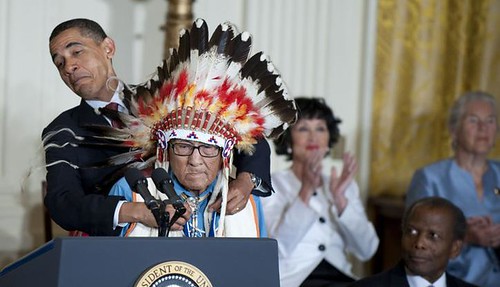
DEALER INGRID O'NEIL ON OLYMPIC MEDALS
In the world of Olympics collectibles, the key to value is rarity. And the rarest commodity is an Olympic medal.
"Everybody would like a winner's medal, but most people can't afford one," said Ingrid O'Neil, who runs an Olympic memorabilia auction out of Vancouver, Wash.
"I would think a winner's medal [from Vancouver] ... it depends if it's gold, silver, or bronze, but I think I would pay on the spot $25,000 for a gold medal."
But she doesn't expect one to come up for a while.
"They will be very, very, very hard to get," O'Neil said.
"Many countries now offer a lot of money to their medal winners, so they don't need to sell their medals any more. When the Soviet Union still existed, the eastern European countries had so little money, if [an athlete] sold their medals for a few thousand dollars that was several years income for them.
"Nowadays I think in Russia they get $50,000 for a gold medal. They don't sell their medals for a few thousand dollars any more."
If you can't lay your hands on a gold, silver or bronze, the next best thing is the "participation medal" every athlete gets for showing up and competing.
"There are a lot of collectors who want participation medals of each Olympiad," said O'Neil, a German who has been dealing in Olympic memorabilia since the mid-1980s.
"It depends on how many are available, [but they can be worth] more than $100 for sure."
"The most expensive medal we've sold is a participation medal for the 1904 St. Louis Summer Olympics," said Chris Ivey of Heritage Auctions in Dallas, which often sells Olympic memorabilia in its sports auctions.
"That's because it's so rare . Everyone who's an Olympic medal collector is looking for this participation medal. It went for $16,700 [US]."
The 1904 St. Louis Games also produced O'Neil's biggest sale: $50,000 US for a gold medal.
"At that Olympiad they had real gold medals," O'Neil said.
"Actually there were four Olympiads that had real gold medals: Paris 1900, St. Louis 1904, London 1908, and Stockholm 1912. Sometimes you hear from [modern] gold medal winners, ‘Oh my gold medal should be worth so much, just for the gold.' They do not realize [they are made out of] six grams of gold over sterling silver. They are not gold."
To read the complete article, see:
Rarity sets prices for Olympic memorabilia
(www.vancouversun.com/sports/2010wintergames/
Rarity+sets+prices+Olympic+memorabilia/2189967/story.html)
I also read this article with great interest as I'm also an Olympic coin collector. But unlike many other Olympic coin collectors I did only concentrate on Atlanta 1996 and Lillehammer 1994 games. Everything else would have been too expensive and time-consuming. Alone from those two games 487 different coins exist. Maybe there are more, but I doubt it. I have found only those during my 15 years of collecting. This includes only coins (official money in an official country - no medals, token or similar). I have roughly 400 of those and I would say that this is one of the most complete coins on earth for those Olympic games (the collection in Lausanne is by far less than mine or Mr. Driegas)
Due to the inflationary issue of Olympic coins (especially from Atlanta 1996 onwards) a complete collection is impossible in my eyes. It took me almost 20 years to collect those coins and the missing 80 coins are probably next to impossible to get. I only know those out of coin books, but have never seen them in a shop, eBay or somewhere else. I would doubt that somebody has the energy and the money to collect really all Olympic coins especially from 1996 onwards. As 1996 is alone 407 coins I would assume that all Olympic coins from 1952 up to now contains at least 2000 coins. So also Mr. Driegas collection is far from being complete but indeed could be one of the most complete collections. Maybe we should bring our two collections together?
So I will continue looking for the remaining 80 coins and maybe one day my collection is really complete. Maybe Mr. Driega or any other Olympic coin collector wants to get in touch with me to exchange some information. Please email me under mctobler@web.de
AMATEURS, PSEUDOSCHOLARSHIP AND NUMISMATIC WORKS
I would not like to sit in the chair of an amateur dentist. Politicians will not finance investigations by amateur nuclear physicists. But when an amateur historian writes a book, no one objects.
Professionalism matters. Much false knowledge will become obsolete once people start to realize that "amateur historian" or "self-taught historian" are just other words for "deficiently trained".
Leon Saryan forwarded this note with the subject line, "I have a problem with this from tonight's newsletter" -
So I thought, OK, this guy thinks that autodidacts are lowlifes, lets see how accurate HIS history is. So I drilled down to the section on Armenia, where I saw three coins illustrated, one of which purports to show a "colt", the second of which purports to be a genuine Tigranes, and the third of which purports to be a gold of Trajan. The "colt" coin could easily be a horse, a donkey, or a mule, the Tigranes might or might not be genuine, and the final coin is definitely not a gold coin of Trajan. I am not much impressed!
George Kolbe (as always) summed things up quite nicely and succinctly:
Many standard, long enduring, "scholarly" numismatic works have been written by "amateurs"; some poor ones have been written by "professionals."
Either you get it right or you do not. That is all that matters.
To read the earlier E-Sylum article, see: ANCIENT HISTORY AND PSEUDOSCHOLARSHIP (http://www.coinbooks.org/esylum_v12n44a22.html)
QUERY: ITALIAN MAKER OF COIN AND MEDAL REPLICAS SOUGHT
Chris Faulkner writes:
Does anyone have the name and location of an Italian company that apparently specialized in the production of replicas, largely of medals, I believe, sometime in the 1950s and 1960s? In his November 1968 column in The Numismatist, "Featuring Fakes," Virgil Hancock reports John Ford alerting him to expertly made high pressure cast counterfeits of 1955 doubled die one cent pieces that had been manufactured in Milan. Who is/was this company? And is this the same company that made replicas of historical and papal medals? Did they publish a catalogue of their replicas?
QUERY: COUNTERFEIT LIBERTY HEAD NICKEL MOLD
Web site visitor (and new subscriber) Jeff Wilson writes:
 I would like some information on the counterfeit V nickel.
I can be reached at jessew61@yahoo.com.
I would like some information on the counterfeit V nickel.
I can be reached at jessew61@yahoo.com.
I have a mold that was dug up by the Wabash river in the town of Russelville IL about 30 years ago. It is carved out of sand stone or maybe soap stone with the date of 1907 or 01. The reverse does have CENT engraved in it.
There was also a dollar mold. It was destroyed by some children who were playing with it.
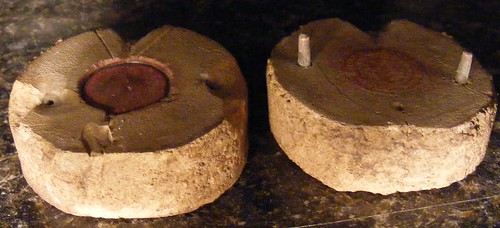
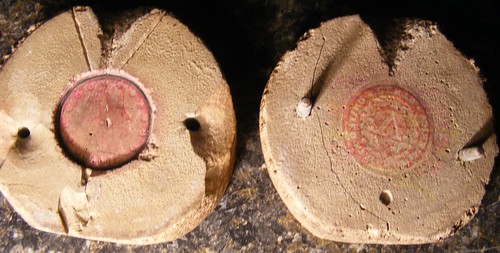
STANFORD WHITE AND AUGUSTUS SAINT-GAUDENS
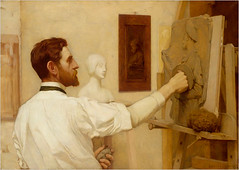 The Metropolitan Museum of Art's exhibition of the sculpture of Augustus Saint-Gaudens, rich with the work of one of the key figures in the American Renaissance, ends next Sunday. A running theme in the show — indeed, in Saint-Gaudens's entire life — is his enduring friendship with the architect Stanford White. As it happens, they were interested in delights not only artistic, but earthly.
The Metropolitan Museum of Art's exhibition of the sculpture of Augustus Saint-Gaudens, rich with the work of one of the key figures in the American Renaissance, ends next Sunday. A running theme in the show — indeed, in Saint-Gaudens's entire life — is his enduring friendship with the architect Stanford White. As it happens, they were interested in delights not only artistic, but earthly.
The sculptor quickly became fast friends with McKim and White, who would design many of the settings for his sculptures. He made a satirical medal to commemorate a trip they made to southern France in 1878. At top, a wild-eyed White stares out from underneath a startling shock of hair, on the right McKim's near-baldness is lampooned with an exaggerated high forehead and at left Saint-Gaudens portrayed his naturally pointy face made even pointier by drawing out his goatee.
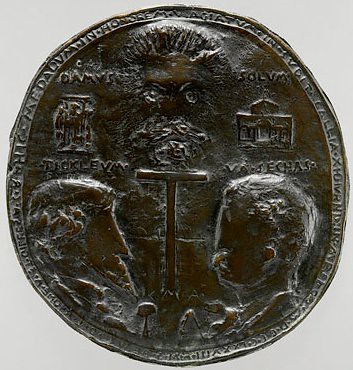
Saint-Gaudens was particularly close to Stanford White, and in 1884 gave White and his new wife, the former Bessie Smith, a marble relief portrait of Mrs. White as a wedding present. But at the same time it is known that the sculptor and architect enjoyed a life of enthusiastic unchastity.
Paul R. Baker is emeritus professor of history at New York University, and his book "Stanny: The Gilded Life of Stanford White" (Free Press, 1989) delicately summarizes their activities in rooms rented by their secret "Sewer Club." Sometimes Saint-Gaudens signed his letters to White with epigrams like "Kiss me where I can't" or a phallic symbol. Such ribaldry may have been traditional masculine ribbing, although Professor Baker notes a continuing thread of homoerotic overtones.
To read the complete article, see: Gilded-Age Monuments and Secrets (www.nytimes.com/2009/11/08/realestate/08streets.html)
ARTICLE HIGHLIGHTS CHALLENGE COIN SELLER'S BUSINESS
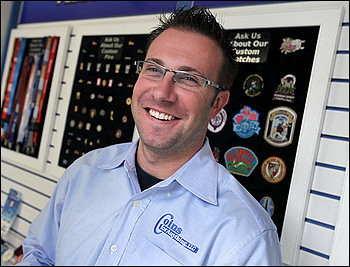 Jeffery Morin's memorabilia business in Stafford probably isn't the next Google or eBay, but I love the 27-year-old's story because it's about a regular guy who saw an online opportunity and went for it.
Jeffery Morin's memorabilia business in Stafford probably isn't the next Google or eBay, but I love the 27-year-old's story because it's about a regular guy who saw an online opportunity and went for it.
Morin was noodling around on eBay, the auction Web site, seven years ago while serving in the U.S. Marine Corps aboard the amphibious assault ship USS Wasp in the middle of the Red Sea. He stumbled across some people selling old military memorabilia coins, about the size of a silver dollar, called "challenge coins." Challenge coins are collectibles used by the U.S. military to commemorate service in a unit or participation in an exercise.
"Poor man's coin collecting," as Morin puts it.
EBay customers were bidding $15 for coins Morin knew he could buy at a Marine Corps base for $5. So when he got back to Camp Lejeune, N.C., he marched to the base store and bought 30 generic Marine Corps coins for $4.50 each. (He persuaded the store manager to knock 50 cents off the $5 price.)
Morin took a photograph of one coin and posted it on eBay. It sold in three days for $11.50, yielding a $7 profit.
He was on to something. During lunch breaks, Morin would run to his barracks, package the coins into bubble-padded envelopes, address them by hand and walk them to the base post office for mailing; the envelope and postage for each coin cost him $1.05, which came off his profit.
His mother lent him $500 to buy more coins, and he was quickly earning $300 to $500 a month from the business. Profits went in to buying more coins.
After about six months, he got an e-mail from an Ohio woman that would result in a big expansion for his nascent enterprise: She had seen his coins on eBay, and could he find a coin dedicated to mothers with sons in the Marine Corps?
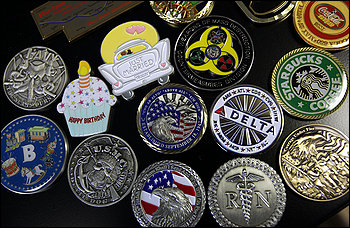 "No problem," said Morin. He paid a fellow Marine $50 to sketch out a design. Then Morin jumped online, searched for "customer minted coins" on Google and found a Georgia company that would turn the design into a mold from which he could make his Marine Mother coins: $300 for the mold and $3.50 per coin. He ordered 100, and the bill came to $750 with shipping.
"No problem," said Morin. He paid a fellow Marine $50 to sketch out a design. Then Morin jumped online, searched for "customer minted coins" on Google and found a Georgia company that would turn the design into a mold from which he could make his Marine Mother coins: $300 for the mold and $3.50 per coin. He ordered 100, and the bill came to $750 with shipping.
Morin looked at blogs to locate more mothers of Marines and found sites like Marine Parents United and Marine Moms Online. He joined the blogs to solicit customers and posted a sketch of the forthcoming coin.
The 100 coins sold out in less than three hours;
"I started to realize . . . there's some money to be made in this business," Morin said.
By the middle of 2003, Morin had left the Marine Corps and was selling $15,000 of coins a month.
Then he bought a book that taught him how to advertise on Google using key advertising words like "custom coins" and "military challenge coins."
"We had orders pouring in," he said. "I had to hire customer service reps."
Within days, he got a call from Target, the retail giant, which led to a contract for 50,000 coins for a "Star Wars" movie premiere the retailer was sponsoring. Morin beat his suppliers down on prices, eventually paying 60 cents per coin and selling them to Target for $1.35. He pocketed around $35,000 on the deal.
Morin was 22.
The enterprise now encompasses five companies that will generate around $5 million in revenue this year, with the coins and trophies representing the vast majority. His costs include $2.5 million for the products, $500,000 in payroll for 16 employees, and about $7,000 a month in rent on a 4,000-square-foot headquarters in a Stafford office park. He pays Google around $1 million a year.
I estimate that Morin's companies earn a net profit of around $1 million; he didn't deny that estimate. He is rolling most of that profit back into his enterprises. A competitor offered to buy the coin company for $4 million a couple of years back.
To read the complete article, see: A tiny niche in collectible coins grows into a $5 million mini-empire (www.washingtonpost.com/wp-dyn/content/article/2009/11/01/AR2009110102261.html)
PERSONAL TOKENS OF COLLECTOR JERRY ADAMS
I started out having the encased cents made by Penny Press Mint of Spanish Fork, Utah. I bought my own UNC wheat cents for the encasements, and sent them to PPM owner Kelly Finnegan. See http://www.pennypressmint.com/ for more information on the company.
I designed the layouts myself. Prior to retirement I worked as an architectural draftsman, so I did the designs digitally, and sent them to Kelly at PPM. Kelly then refines the designs and sends digital images back to me for approval. The process went smoothly and I had several types of encased cents done.


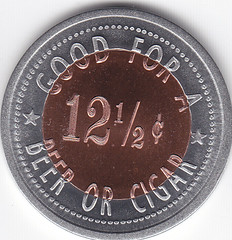
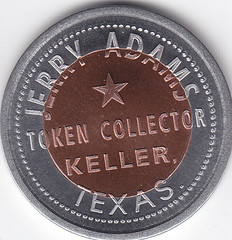
Later I contacted PPM about making a "non-encased" token for me to use as a personal token, and Kelly worked with me in the same manner, to produce the design for both the obverse and reverse dies for the personal token runs, in both bimetal and aluminum. Currently Penny Press Mint is working with me again on designing another die, for an additional personal token, which may be ready in 6 months or so.
The whole process is a lot of fun, and I think Kelly at PPM enjoys the process as much as I do!
Here is a photo of Kelly Finnegan of PPM at his table at the 2009 Salt Lake City NTCA show, holding two of the dies that struck my personal tokens:
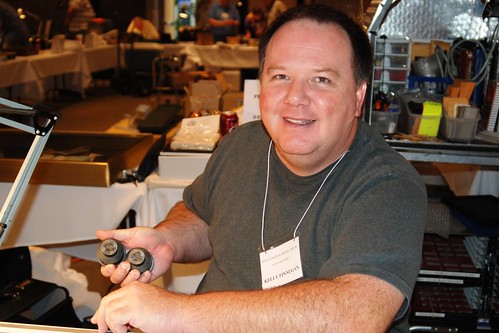
Kelly Finnegan
To view all the token images, see: s60.photobucket.com/albums/h8/clovisfirst/ESYLUM/
Jerry adds:
I enjoyed reading the article on the B. Max Mehl occupation as a pneumatic broker! since I live basically in Fort Worth (5 miles north), I am familiar with Mr. Mehl's legacy.
The fact the census taker listed him as pneumatic broker, shows something i have noticed in census records. Sometimes they get words messed up, perhaps it is the writing or the hearing of what the person said, or the basic understanding of terms of the census taker.
One particular guy I researched, G.W. Felt, who was an Indian Trader, ...I found him listed in the 1880 census on line as occupation as "Indian Traveler" rather than Indian Trader. This error could have happened a number of ways, either the person reading the hand written census may have misread the script writing and mistook "trader" for "traveler" or it was written in the census as traveler, etc. Personally, I believe the person transcribing it made an error and typed in Traveler rather than trader. Old handwriting is often hard to read.
Bob Leonard (Past President of the Token and Medal Society) writes:
Jerry Adams is not a current member of the Token and Medal Society, so perhaps he is unaware that TAMS has well over 800 members. Certainly TAMS is "the largest group of collectors of trade tokens [and other exonumia] in the world."
MORE ON JAMES J. CURTO
Last week I asked if any of our readers knew Jim Curto. Bob Leonard writes:Not mentioned in the biography of James J. Curto is that Curto was President of the Token and Medal Society 1962-1963. Beautiful high-relief portrait medals of him are still available from TAMS.
I never met James Curto, but he wrote me after my article "Fort Riley, Kansas, Tokens" appeared in The Numismatist (February, 1966, reprinted in A Survey of American Trade Tokens edited by David W. Schenkman) to advise me of earlier Fort Riley tokens. I believe that I sold the set of pieces described in the article to him.
Ken Hallenbeck writes:
I knew Jim Curto. He lived in Grosse Pointe, MI, and I lived in Ann Arbor. This was in the late 40s and early to mid 50s. I was a young guy at the time (in my teens) and he was always kind and polite to me. We shared an interest in Michigan Civil War Store Cards along with a man named Cliff Temple. I went to the Detroit Coin Club once or twice and recall having a pretty good time for a teenager along with all those "old" guys, - - - now I are one!
I also recall an old time coin dealer from Detroit, Harold Bowen, author of a book on Michigan items, who got me started on my set of The Numismatist by giving me a run of them from about 1935 to 1955 or so. As I was then an ANA member (60 years now) I was able to keep up with them currently at that time.
To read the earlier E-Sylum article, see: TOKEN COLLECTORS NAME AWARD FOR JAMES J. CURTO (www.coinbooks.org/esylum_v12n44a13.html)
THE BOOK BAZARRE
AUTHOR GINGER RAPSUS ON WRITING CLAD COINAGE BOOK
 Writing about coins was just as enjoyable as observing and collecting coins. I had been an English major in college and was editor of the school newspaper for years, so this was something I could do for fun.
Writing about coins was just as enjoyable as observing and collecting coins. I had been an English major in college and was editor of the school newspaper for years, so this was something I could do for fun.
With all of my interests, research and reading and studying, I had yet to see anything major on clad coinage. The clad coins appeared in 1965, and were definitely not favored by collectors. By 1990, the clads had been around for 25 years, but I rarely saw anything in print or any mention of them.
The changeover from silver to copper-nickel clad coins had been a major part of coin history. I wanted to read a great amount about these coins and what led up to their creation, but there just wasn't anything there. These coins, though modern, were just as much a part of U.S. coin history as any other coins, and important in their own way. All a clad collector could find to read were back issues of coin magazines. That's when I decided to do something about this missing part of coin history. I decided to write my own history of the clad coins.
I notified my collector friends about my new project. I accumulated old articles, from coin publications and newspapers, an article from a metal working magazine and lots of feedback from those who remembered when the clad coins were released. My pile of documents filled a small basket. Library books, from the ANA library and more local libraries, were also used in my research. After about five months of accumulating information, the writing began in earnest.
Writing up my research, carefully documenting the legal aspects, and featuring an entire chapter on selecting the metal for coinage took much of the time. Actually, I wrote the chapter on the metals first, it was so fascinating to me. There was the Bible bill, introduced by Sen. Alan Bible of Nevada, that could have outlawed the hobby. There were mintage figures, and the question of the 1970-D half dollar, made for collector mint sets only. I found a discrepancy in the mintage figure and the total of mint sets released. I had letters and figures from collectors who had pulled coins out of change to see what dates and mintmarks showed up the most. There were plenty of 1965, 1966 and 1967-dated coins, but hardly any 1968-D or 1969-D coins.
Bowers and Merena published the finished product in 1992. How proud I was to hold the book in my hands. Here was my research, my writing project, on a neglected area of U.S. coinage. I had used my writing and research, that I enjoyed, to contribute something big to the hobby I loved.
To read the complete article, see: Hobby Writer Wrote History of Clad Coins (www.numismaster.com/ta/numis/Article.jsp?ad=article&ArticleId=8154)
NATIONAL PUBLIC RADIO SEGMENT ON LOS ANGELES ANA CONVENTION
The hall was teeming with numismatists. That is to say, coin collectors buzzing around a vast acreage of display cases filled with exciting things like Estonian kroons and Filipino Treasury Certificates.
There was also a huge display case filled with millions of bucks in old currency. Jay again.
BEETON: These are $100,000 notes. These were never made for general circulation, but they were made for bank transfers back in the day when you would hire a runner on a bicycle and he'd uh.
Ah, now the reason he stopped talking was because, all of a sudden, this huge guy walks up with a security guard, removes a million dollars from the display case and starts posing for photos with it. Hello.
PETERS: Who is this guy?
BEETON: That's Hillbilly Jim the wrestler.
PETERS: Hillbilly Jim the wrestler?
BEETON: He was a wrestler in the WWF for years and what have you.
Oh, that Hillbilly Jim, always kidding around. Turns out he's also a serious coin collector. He has the pony-tail and everything.
I was going to ask him a lot more, but the next thing I knew he was wrestling with some guy from the U.S. Treasury.
To read the complete article, see: It's still a coin collector's world (marketplace.publicradio.org/display/web/2009/11/05/pm-coin-collecting/)
BROOKLYN WOMAN FINDS ARTIST'S CENT MADE OF GOLD
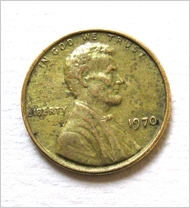 One afternoon in March 2007, Jack Daws stepped up to a newsstand in Los Angeles International Airport with a handful of change, including a counterfeit penny made of 18-karat gold that Mr. Daws, a Seattle artist, had fashioned. He carefully put the counterfeit penny, dated 1970, down on the counter, counted out enough change to pay $11.90 for a Hustler magazine and left.
One afternoon in March 2007, Jack Daws stepped up to a newsstand in Los Angeles International Airport with a handful of change, including a counterfeit penny made of 18-karat gold that Mr. Daws, a Seattle artist, had fashioned. He carefully put the counterfeit penny, dated 1970, down on the counter, counted out enough change to pay $11.90 for a Hustler magazine and left.
He got a cup of coffee and sat down on a seat with the newsstand in sight, and watched for an hour wondering if any of the travelers had walked off with his golden penny and where it would end up at the end of the day.
Most counterfeiting takes something that is nearly worthless and turns it into something perceived to have value. Mr. Daws did just the opposite. He took value — approximately $100 worth of gold — and turned it into something perceived as nearly worthless, one cent. "It's there, but if people don't realize it, it's the same as not being there," he said. Of the 11 copper-plated gold pennies he made as part of his series, only this one was sent into the wider world.
He never expected to see it again, but he wondered where the penny ended up: stuck in a giant penny jar, melted down with other coins back at the United States Mint, lost in a street gutter. Meanwhile, one of his other counterfeit pennies sold for $1,000 to a collector through the Greg Kucera gallery.
Then, Mr. Daws woke up one morning in October and listened to a voicemail left by a Brooklyn graphic designer named Jessica Reed.
"I think I found your gold penny," the message said.
How the golden penny traveled, through how many hands or cash registers, over the two years, may never be known. But now the journey has reached its endpoint.
Late this summer, when Ms. Reed was paying for groceries at the C-Town supermarket in Greenpoint, she noticed the penny because the gold color had started to peek through. A fan of unusual coins, she slipped it back into her change purse and tucked it into the recesses of her mind.
Then recently, while doing research about a 1924 Mercury-head dime, she remembered the penny and typed "gold penny" into Google, which returned information on science experiments to give a penny a gold color. She added "1970" and found an item about how Mr. Daws had put a 18-karat gold penny, dated 1970 with no mint mark, into circulation. It was heavier and smaller than a real penny.
In disbelief, she weighed the penny on a digital scale. It came in at three grams, one gram more than similar pennies from 1970. And it was slightly smaller than a normal penny, owing to the shrinking after the casting process.
She traced Mr. Daws's phone number through the gallery and left him the message. When he called back, he knew it had to be his penny as soon as she described it to him.
Ms. Reed will keep the coin. She is thinking of having it framed. It's was a curious way to display a sculpture, she said. "I can't imagine being an artist who does something like this," she said. "It's the opposite of having your stuff shown in a gallery. It could be tossed."
To read the complete article, see:
Brooklyn Woman Finds Counterfeit Penny Made of Gold
(cityroom.blogs.nytimes.com/2009/11/04/
maker-learns-the-fate-of-a-penny-made-of-gold/)
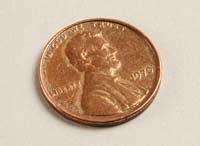 Los Angeles, California, March 29, 2007 - American artist Jack Daws put one of his sculptures in circulation this week at Los Angeles International Airport (LAX). It is no ordinary artwork; it is a copper plated, gold penny.
Daws hired metalsmiths to make a mold of a penny, cast it in 18-karat gold, and then copper plate it. He carried the sculpture in his pocket for months, during which time it developed a brown patina. The artwork looks like a real penny, except due to the casting process, it's slightly smaller, and because of the gold's weight, it's almost twice as heavy.
Los Angeles, California, March 29, 2007 - American artist Jack Daws put one of his sculptures in circulation this week at Los Angeles International Airport (LAX). It is no ordinary artwork; it is a copper plated, gold penny.
Daws hired metalsmiths to make a mold of a penny, cast it in 18-karat gold, and then copper plate it. He carried the sculpture in his pocket for months, during which time it developed a brown patina. The artwork looks like a real penny, except due to the casting process, it's slightly smaller, and because of the gold's weight, it's almost twice as heavy.
Whoever finds the sculpture could sell it for the value of the gold, but they might want to hold onto it. Daws has more of them, and his Seattle art dealer, the Greg Kucera Gallery, is selling them. Prices start at $1000.
When asked if he was concerned about possible criminal charges for counterfeiting, Daws replied, "If they're looking for criminals they should raid the White House and the Capitol."
To read the complete article, see: Counterfeit Penny put in Circulation (www.gregkucera.com/daws.htm)
It's an interesting parallel to the performance art of J.S.G. Boggs, who "spent" his art works at face value; those who accepted them later learned they were actually worth much more to collectors. -Editor
ARTICLE HIGHLIGHTS ASHMOLEAN COIN COLLECTION
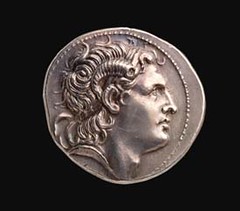 The £61m redevelopment at the Ashmolean Museum has made headlines this week, but another money-related story of no less interest can be found at the new building in Oxford.
The £61m redevelopment at the Ashmolean Museum has made headlines this week, but another money-related story of no less interest can be found at the new building in Oxford.
The museum is also home to a raft of coins ranking among the ten most important monetary collections in the world, containing 300,000 monetary objects which, until now, had been tucked away in a remote vault which visitors dared not enter.
When the museum reopens this weekend many of the coins will have a dedicated gallery, where a bold caption on the wall proclaims money to be "the value of the past".
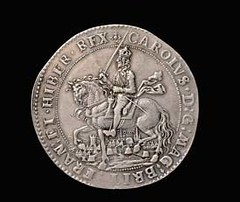 With displays from ancient Britain as well as India and the Middle East, plus Greek and Roman coinage, it is hoped that gallery seven will be a microcosm of the rest of the museum.
With displays from ancient Britain as well as India and the Middle East, plus Greek and Roman coinage, it is hoped that gallery seven will be a microcosm of the rest of the museum.
The Heberden Coin Room, as the collection is known, reaches much further into the new museum, since coins are showcased in 25 of the 35 permanent galleries.
"As storytelling items, coins work very well because they contain iconography," says Project Curator David Berry, explaining why such small objects appeal to so many departments.
 "It allows us to integrate a part of the collection in a way that is meaningful, not just for the sake of it."
"It allows us to integrate a part of the collection in a way that is meaningful, not just for the sake of it."
By way of example, Berry highlights a coin which depicts Henry VIII as head of the Church of England. The museum is able to display it beside a sword formerly presented to the king in recognition of his role as defender of the Catholic Faith.
The Ashmolean Museum opens on November 7 2009. Admission free
To read the complete article, see: World class coin collection shines at Ashmolean (www.culture24.org.uk/history+%2526+heritage/art73200)
BULGARIAN MUSEUM SEEKS FUNDS TO DISPLAY ANCIENT COIN HOARD
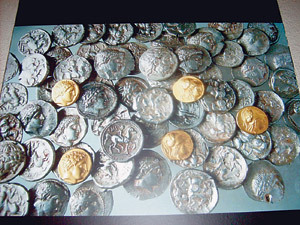 The biggest gold treasure in Bulgaria has been locked for 40 years. For several decades already the state authorities have been trying to discover the missing coins from the hoard, which was once a part of the treasury of Alexander the Great (336-323). The 80-kilogram weighing hoard is kept in a safe for lack of exhibition equipment.
The biggest gold treasure in Bulgaria has been locked for 40 years. For several decades already the state authorities have been trying to discover the missing coins from the hoard, which was once a part of the treasury of Alexander the Great (336-323). The 80-kilogram weighing hoard is kept in a safe for lack of exhibition equipment.
Two farmers, father and daughter discovered the fabulous riches of gold in 1968 near the Breznik village of Rezhantsi. One night, the two of them had been ploughing a furrow in the field when the tractor crashed a large earthen pythos, the size of a big amphora. The trasure – coins of pure gold and silver – was escorted by militia to the Pernik Museum of History, but the discoverers of the hoard, as well as some of the shepherds in the region, kept for themselves some of the coins.
Some of the lost pieces were seized by the police and deposited for safe-keeping at the Sofia Museum of Archaeology. The coins date back from the fourth century BC. They bear the images of Philip II of Macedon (359-336), his son Alexander III of Macedon and Paeonian ruler Patraeus (335-315). According to the experts, the gold hoard was meant for salary of Alexander the Great's army, which was defeated by the Thracian tribes in this region.
Ironically, the biggest gold treasure in Bulgaria has been locked for decades and hasn't been exhibited by now. According to Simeon Milyov, head of the Pernik Museum of History, the museum needs some 8,000 levs (1 euro=1.95 levs) to buy a numismatic showcase for the exposition of the priceless coins.
To read the complete article, see: Gold Treasure Kept Hidden for 40 Years (history-of-macedonia.com/wordpress/2009/11/04/gold-treasure-hidden-40-years/)
FEATURED WEB PAGE: WWI EMERGENCY MONEY
This week's Featured Web page is on emergency money of World War I, from the National Bank of Belgium web site.
Everybody knows probably the stories about butter and eggs which have been smuggled from the countryside to the city during the war. But how were these butter and eggs paid for?
At the outbreak of the First World War the old bills from the National Bank maintained in circulation. From 1912 onwards the National Bank started to take measures in consideration of a growing armed conflict. Five franc bills were prepared to be put into circulation in case a war should break out. The threatening international conflict spread panic among the population. People no longer trusted banknotes and at the end of July and the beginning of August 1914 they hurried to the National Bank in order to exchange their bills for coins. On top of this, a problem arose in the small money transfer. The five franc coin and the small silver coins were hoarded for their metal value and gradually disappeared from circulation. To solve this problem the National Bank brought out bills at the value of 1 and 2 francs of the current-account type. However, this would not end the problem of the scarcity of money.
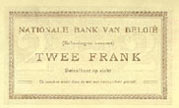
www.nbbmuseum.be/2007/02/emergency-money.htm


